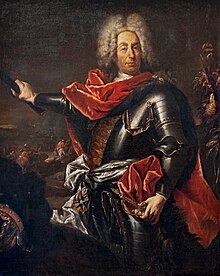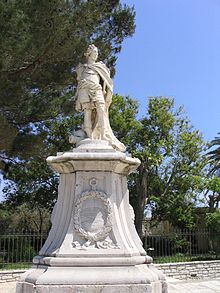Matthias Johann von der Schulenburg
Matthias Johann Freiherr von der Schulenburg , since 1715 Count von der Schulenburg , (born August 8, 1661 in Emden , † March 14, 1747 in Verona ) was Field Marshal General in the service of the Republic of Venice and heir to Emden and Dehlitz . He came from the German noble family von der Schulenburg . When Emperor Charles VI. raised him to the rank of imperial count , he was the first in the family with this title.
Life
He was born as the son of the Kurbrandenburg privy councilor and chamber president Gustav Adolf von der Schulenburg and Petronella Ottilie. von Schwencken adH Haselünne was born. After studying in Paris and Saumur , he joined Duke Anton Ulrich von Braunschweig as a chamberlain in 1685 . From 1687 to 1688 he fought as a volunteer with the imperial troops in Hungary against the Turks . On his return he was appointed senior chamberlain and captain of an infantry company. In the next few years he rose rapidly in the military hierarchy of the duchy (1692 lieutenant colonel , 1693 colonel ) and subsequently commanded growing troop contingents in Braunschweig, for example during campaigns on the Rhine. At the same time he worked for the Duke in diplomatic missions.
In 1699 Schulenburg entered the service of Duke Viktor Amadeus II of Savoy with the rank of major general (and later colonel) of a German regiment , took part in the suppression of the Waldensian rebellion in 1699 , fought against Prince Eugene of Savoy in 1700 , led a brigade in 1701 the army of Marshal Nicolas Catinat , but after a serious wound asked to leave the duke's service.
General in the service of Saxony-Poland
In 1702 he was accepted into the army of August II of Poland with the rank of lieutenant general and took part in the Great Northern War fighting the Swedes. In the battle of kliszów (July 9 jul. / July 20, 1702 greg. ) He was the commander of the Saxon infantry first time the Swedish King Karl XII. opposite and prevented the encirclement of the Saxon army by a quick retreat across the Nida . In the following year, as part of the War of the Spanish Succession , he commanded the Imperial Quota of Electoral Saxony in the Upper Palatinate and on the Upper Rhine.
In 1704 he was given command of the Saxon-Polish field army near Warsaw by August the Strong. Since he did not dare to fight the advancing Swedes, he initially withdrew to Posen , where he hoped to unite with a Russian contingent under Johann Reinhold von Patkul , which, however, was wiped out almost to the last man by the Swedish superiority (9 August 1704). Before the following Swedes under Charles XII. Schulenburg led the remaining Saxon troops through a masterful retreat to Silesia . After he fought off the attacking Swedish dragoons in the last battle near Punitz (October 28, 1704) shortly before the Silesian border, his army withdrew across the Oder to Saxony. In recognition of his achievement, especially his steadfastness against the undefeated Swedish war hero Karl XII, Schulenburg was promoted to general of the infantry by August II .
At the head of a corps made up of Saxon and Russian troops, Schulenburg again entered Poland in January 1706. Before he could unite with the main contingent of Augustus the Strong, as ordered, he allowed himself to be seduced into an attack by a fake retreat by the Swedish Field Marshal Carl Gustaf Rehnskiöld . In the battle of Fraustadt on February 13th, he was defeated despite his numerical superiority. Schulenburg, who was wounded in the hip in battle, justified himself to the king because his soldiers and especially the cavalry ran away "cowardly" despite their good positions. In his report he called for a strict court martial against the deserters, which the king actually held by sentencing thirty dragoons to the gauntlet and executing fourteen.
After the Peace of Altranstädt (September 24 / December 19, 1706), to which Saxony was forced by a Swedish advance as far as the Elbe , Schulenburg continued to work on the diplomatic mission of August II.
In 1707 von der Schulenburg returned to active military service and fought in the War of the Spanish Succession in Flanders , where he first took part in the battle without a command, then from 1708 at the head of a Saxon troop contingent under the leadership of British commander John Churchill, 1st Duke of Marlborough participated in Oudenaarde and the sieges of Lille and Tournai . In the battle of Malplaquet on September 11, 1709, Schulenburg commanded 40 battalions of Saxony and other imperial troops, who carried the brunt of the battle. He then took part in the siege of Mons and in 1710 under Prince Eugene in the siege of the cities of Douai and Béthune , which he forced to surrender on August 28.
Field Marshal of the Republic of Venice
In April 1711, the Saxon crown granted his request for discharge from the army. After trying in vain to enter imperial service, he was accepted into the service of the Republic of Venice on October 15, 1715 with the rank of field marshal , initially for three years and later for life. At the same time he was from Emperor Charles VI. raised to the rank of imperial count .
The Serenissima had come into greater military distress due to the declaration of war by the Ottoman Empire in 1715 and the subsequent loss of the Morea Peninsula (Peloponnese), and Schulenburg was considered the right man for the supreme command of the Venetian land army because of his defensive qualities. The defense of Corfu (from July 25 to August 20, 1716) against the Turks, which he directed, is (according to Meyers 1888) one of the most famous achievements in modern war history. She was allegorically glorified by Antonio Vivaldi in the oratorio Juditha triumphans . It was followed by the capture of the fortress of Butrinto and the occupation of Santa Maura .
As a thank you for his outstanding deeds, the Republic of Venice decided in the war year 1716 to erect a monument to him in Corfu . The marble statue was created by the sculptor Antonio Corradini .
In 1718 Schulenburg undertook an incursion into Albania with the help of the Venetian fleet , but had to withdraw again as a result of the Peace of Passarowitz . The successfully started siege of the port of Dulcigno ( Ulcinj in today's Montenegro ) - by sea and land - was lifted again, and the Venetian expeditionary army - with German, Swiss, Italian and Dalmatian troop contingents - embarked, albeit with major losses of their own disciplined again.
For the next 29 years Schulenburg was a constant in Venice's foreign policy. In a realistic assessment of the remaining forces, he primarily focused on securing the republic and its position in the Adriatic region by expanding the fortresses (especially Corfu) and the defensive forces.
Prince Eugene of Savoy and the Duke of Marlborough highly valued Matthias Johann von der Schulenburg's military abilities and expressed this in their correspondence with the Field Marshal that went beyond military questions. He was also valued by the King of Prussia, Friedrich Wilhelm I , and in 1739 awarded Schulenburg the highest Prussian award, the Order of the Black Eagle .
Schulenburg as a collector and patron
During his more than thirty years' stay in Venice (at the invitation of his comrade in arms from Corfu, Antonio Loredan , he stayed at the Palazzo Loredan , which later served as the residence of the ambassadors of the Holy Roman Empire), Schulenburg developed into an enthusiastic art collector and patron of contemporary artists. In addition to a considerable inventory of paintings by old masters, the focus of his collecting activities was on contemporary Venetian painting of his era. The field marshal became one of the most important patrons of painters such as Sebastiano Ricci , Giambattista Piazzetta , Francesco Simonini (* 1686; † after 1753), Giacomo Ceruti and Antonio Guardi . From 1736/37 his collection was sent to Berlin in thirteen consignments, where it was exhibited in the gallery of the newly built Berlin Palais von der Schulenburg at Wilhelmstrasse 77 (later: Old Reich Chancellery ). In Germany, the Field Marshal's “unsteady gallery”, as it has been called, was in direct competition with the princely collections of paintings. It was one of the largest, if not the most important, collection of a non-ruling house and in Prussia the most important art collection after the royal one.
Death in Verona
Matthias Johann Graf von der Schulenburg died on March 14, 1747 in Verona at the age of 86. Posthumously , like General Otto Wilhelm von Königsmarck before him , he was honored by the Serenissima with a monument, which is placed in the large atrium of the arsenal of Venice . This grave monument contains a marble portrait relief and comes from the important Venetian sculptor Giovanni Maria Morlaiter . In Verona there is a monument in the Cortile del Tribunale.
Schulenburg's sister Ehrengard Melusine became the Duchess of Kendal as the mistress of the British King George I of Great Britain . His younger brother Daniel Bodo von der Schulenburg was a Saxon-Polish lieutenant general.
literature
- Heiner Krellig (et al.): Field Marshal and Art Collector. Matthias Johann von der Schulenburg (1661–1747). An unknown inventory of works of art from his collection in the possession of the Counts of Schulenburg-Wolfsburg. Konkol, Wolfsburg 2011, ISBN 978-3-931481-27-8 (Wolfsburg Contributions to History and Art History, 4)
- Alice Binion: La galleria scomparsa del Maresciallo from the Schulenburg. Un mecenate nella Venezia del Settecento. Electa, Milan 1990, ISBN 88-435-3291-X ( Ateneo Veneto 4).
- Karl August Varnhagen von Ense : Count Matthias vd Schulenburg. In: Varnhagen: Biographical monuments. 1st chapter. G. Reimner, Berlin 1824, pp. 130ff
- Anonymous (= Friedrich Albrecht Graf von der Schulenburg): Life and Memories Johann Mathias Reichsgrafen von der Schulenburg, heir to Emden and Delitz, Field Marshal in the service of the Republic of Venice. 2 volumes. Weidmann, Leipzig 1834. Volume 1 , Volume 2
- Werner von der Schulenburg : The King of Corfu. Westermann, Braunschweig et al. 1950 (historical-biographical novel with a focus on the defense of Corfu).
- Dietrich Werner Graf von der Schulenburg, Hans Wätjen: History of the family from Schulenburg. 1237 to 1983. Niedersachsen-Druck und Verlag Hempel, Wolfsburg 1984, ISBN 3-87327-000-5 .
- Paul Zimmermann : Schulenburg, Matthias Johann (Count) of the . In: Allgemeine Deutsche Biographie (ADB). Volume 32, Duncker & Humblot, Leipzig 1891, pp. 667-674.
Web links
- Picture of the Schulenburg monument in Corfu, including some information about the battle
- Correspondence from Schulenburg with Frederick the Great
swell
- ^ Leopold von Zedlitz-Neukirch : New Prussian Adelslexicon , Volume 2, Page 87.
- ↑ Binion: La galleria scomparsa del Maresciallo from the Schulenburg 1990 and Krellig: "Field Marshal and Art Collector" 2011.
| personal data | |
|---|---|
| SURNAME | Schulenburg, Matthias Johann from the |
| ALTERNATIVE NAMES | Schulenburg, Johann Matthias Graf von der; Schulenburg, Matthias Johann Graf von der |
| BRIEF DESCRIPTION | German imperial count, heir to Emden and field marshal in the service of the Republic of Venice |
| DATE OF BIRTH | August 8, 1661 |
| PLACE OF BIRTH | Emden |
| DATE OF DEATH | March 14, 1747 |
| Place of death | Verona |



